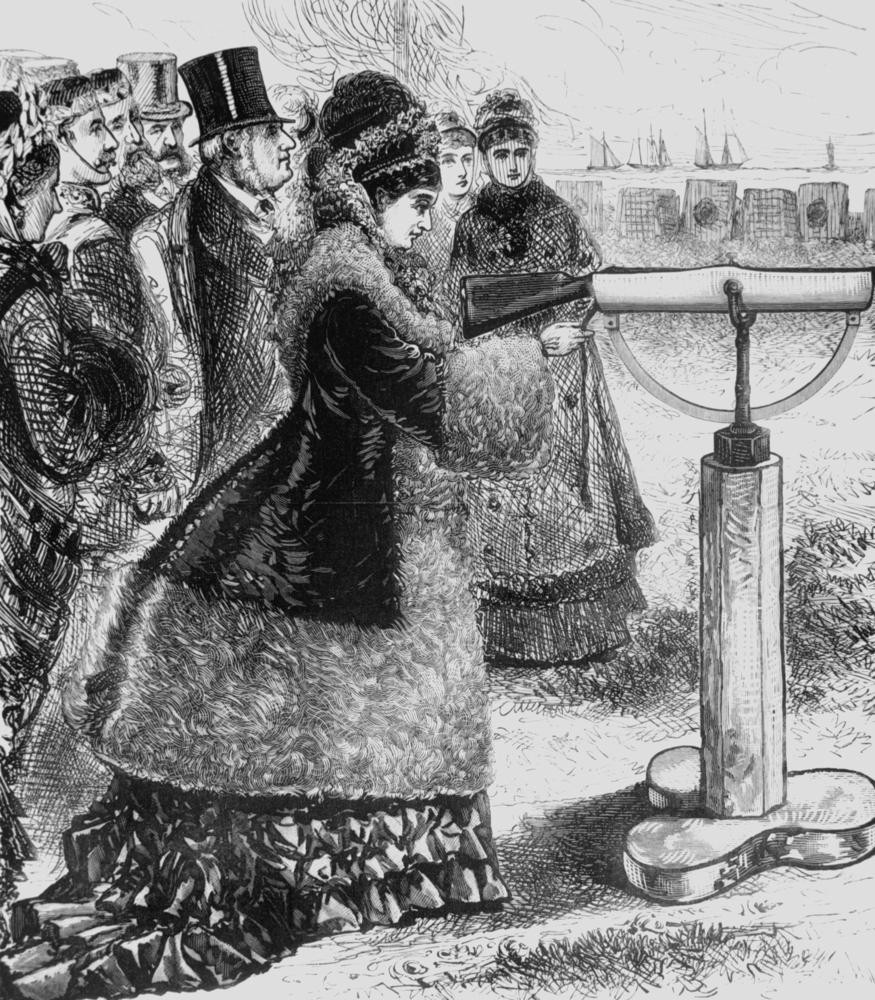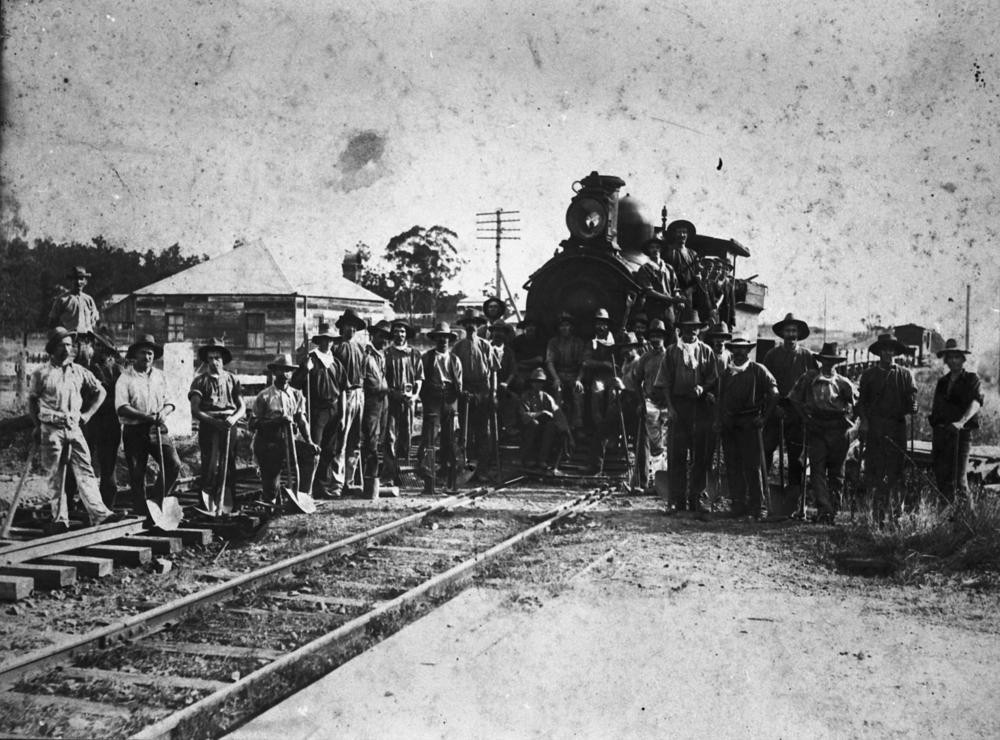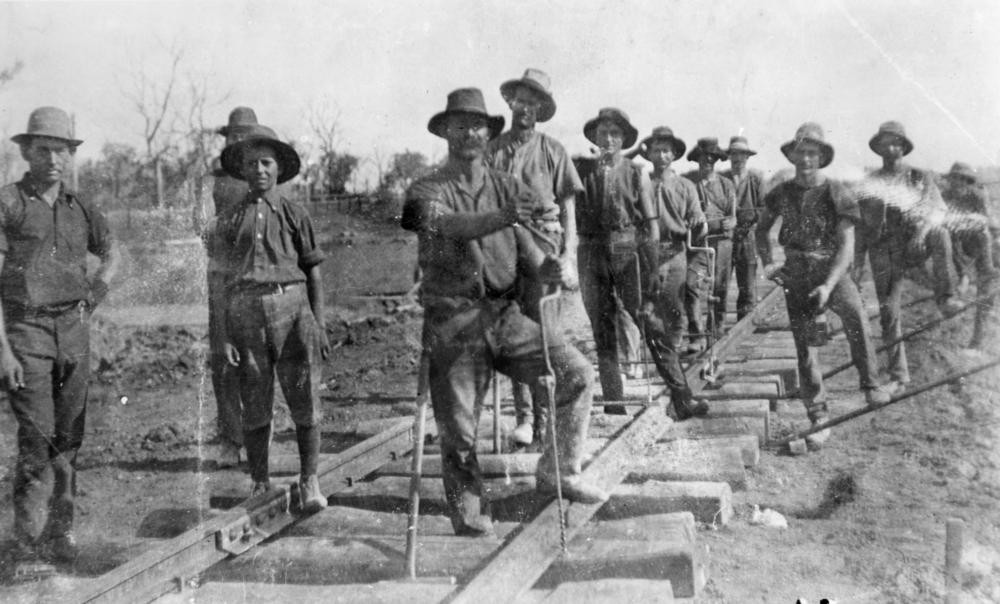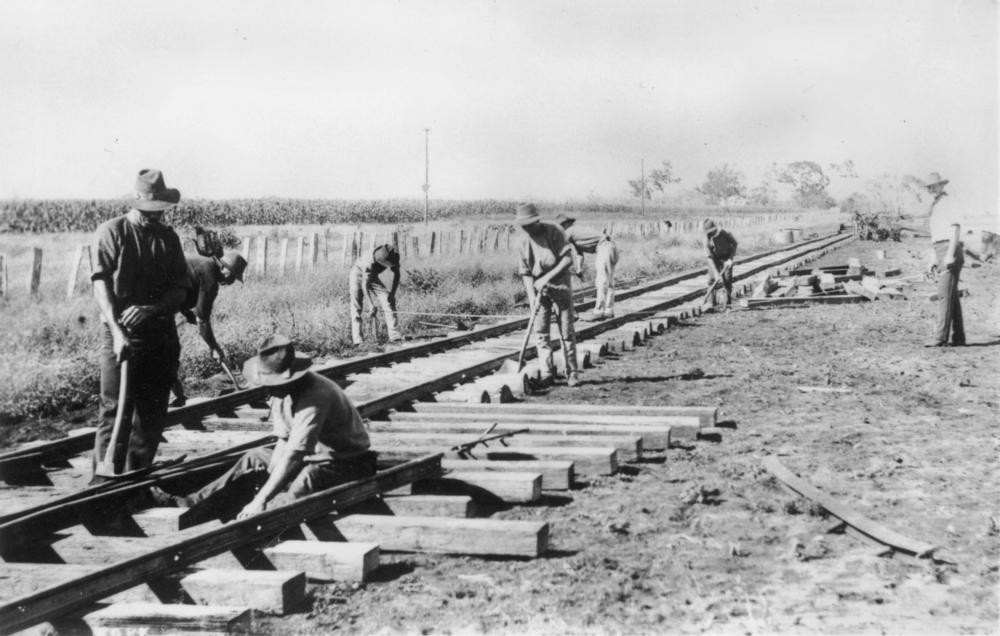Building the railways : one man's story
By Simon Miller, Library Technician, State Library of Queensland | 25 May 2015
It was in the year 1864, when a boy of twelve years, that I started my first of many years as a Railway man. My home being in the Walloon district I heard of the projected commencement of the first permanent railway in Queensland, it being also the first section of the Southern and Western Railway. This line was from Ipswich to Bigge’s Camp (now Grandchester). I was engaged as a nipper, my occupation being to holdup sleepers whilst they were being spiked to the 3’6” gauge.
On February 25th, 1864, a date which will ever remain an eventful day in the history of the Queensland Railways, Lady Bowen, wife of the then Governor of Queensland, turned the first sod and also, about six months later, drove the first spike on the first railway in Queensland. It was my privilege to holdup the first sleeper that was spiked by her ladyship.

Lady Bowen was often called upon to open things. Here she is firing the first shot at the Victorian Rifle Range
William Robert Morrow was born in Ireland in 1853 and his parents migrated to Queensland in 1855 aboard the ship Fortune. His father Robert Morrow worked for a while in a mill before taking up a selection at Campbell's Gully near Walloon, west of Ipswich. Williams older brother, Henry went on to become chief inspector responsible for maintenance on the Queensland Railways. We are fortunate to have a copy of William Morrow's reminiscences of his 58 years working on building Queensland's railways. Just how State Library came to hold a photocopy of a typewritten manuscript of William Morrow's account is not recorded. We don't know if William typed the memoir himself, some time in the 1920s or if it is a later transcription of a hand written account. We do know something of his purpose in writing the account from his own words.
My whole aim in penning this narrative is to bring from behind the scenes the resourcefulness of the engineers, the hardships of the men, and above all the pluck and grit of the women folk. How many of the numerous travellers, who daily use the railways as a means of conveyance ever pause to pay tribute to these pioneers of railway building? The work of the engineers and their difficulties, if any, I have detailed in the main Narrative, but here I wish to dwell for a time and repeat some of the inconveniences and hardships of the workmen and their womenfolk. Scheming and dodging was a thing unknown to these hardy railway pioneers, and to work ten hours a day under great difficulties for some forty five shillings a week and also to shift camp in their own time was a lot the workmen of these early days had to contend with. The wives and mothers deserve dual credit, inasmuch, that they sacrificed their own comfort to be with their husbands and sons and by so doing the section was generally completed by the same body of men who commenced it. Living in tents in all sorts of weather through rain and sunshine, did not dishearten these hardy pioneers.

Railway workers at Grandchester Railway Station on completion of the first railway line in Queensland
The bulk of the account talks about the many sections of railway line that William Morrow worked on, the engineering challenges, bridges required and occasional accidents and incidents that occurred. He does not deal with personal matters such as his marriage and children although he does mention various promotions that he received.
Under contractor Dan Williams the Gowrie Junnction to Warwick section was commenced. It was on this line that I received my first promotion, that being from a nipper to leading rail borer. My wages as a nipper were 3/6 a day and on my promotion to leading rail borer I received the magnificent rise of 2/- and on 5/6 a day I worked right through to Warwick.

Workers on the Rockhampton to Marlborough railway line ca. 1920
Late in the account he briefly mentions an accident, this being squeezed in after a listing of the bridges built on the Almaden to Einasleigh line in North Queensland.
On this line I met with rather a serious accident in which I lost one of my legs, being incapacitated for 18 months. At the time of the accident I was a permanent way inspector - a position I had held for the previous 7 years. A strike lasting 6 weeks occurred on this section owing to a wages dispute but it proved to be of very little benefit to the men.
Fortunately we can learn some details of William Morrow's family life from an obituary published in the Cairns Post on June 27 1939.
There passed away peacefully at the Mareeba District Hospital, on Tuesday, June 23, another of that brave band of pioneers who helped to make the north the rich province it is today, in the person of Mr. William Robert Morrow, at the ripe old age of 83. Deceased was born at Woolon, near Ipswich, where the early part of his life was spent. He was married in Bundaberg in 1881 and with his wife then left for their first home at Gin Gin, where he was engaged in railway construction. In his reminiscences the late Mr. Morrow recalled the spiking of the first sleeper on the Queensland railways. He was then a lad of 13 years working on the railway construction, and it was he who held up the first sleeper that was spiked on the Queensland railways, for Lady Bowen, wife of the then Governor of Queensland, Lord Bowen, to drive the first spike home. That was in 1864 and for the Ipswich Grandchester railway line on the first 21 miles of railway laid in Queensland. Lady Bowen presented him with a sovereign for his part of the work. Seven years later he was in charge of the construction work, and from that time on he had always been the man in charge and even after the retiring age his long experience in every branch of railway construction had occasioned his being called upon not only for advice but often again to take charge of some particular work requiring skilful handling. He received an injury to his foot some years ago whilst in the service at Einasleigh and was conveyed to the Chillagoe Hospital, where his foot was amputated. So strong and healthy was he that he was allowed to return to his home at Mareeba after a month in hospital. With an artificial limb the late Mr. Morrow was able to get about as well as most men of his age who were not suffering from such a handicap. It was only during the present year that he went with his wife to New Guinea to attend the wedding of a grand-daughter. Deceased came to reside in Mareeba with his wife and family over 30 years ago. He is survived by his wife, five sons, Bob, Sam, William (Brisbane), Ned (Samari), Harry (Ayr), and three daughters, Mrs. A. Cater (Mareeba), Mrs. Martin (Herberton) and Mrs. Gribbon (Samari). A son and daughter predeceased him some years ago.

Workers laying the rails for the Pittsworth to Millmerran railway ca. 1911
The first section of railway line built in Queensland went from Ipswich to Bigge's Camp, later renamed Grandchester, and was the first part of the railway that would go to Toowoomba and on to Dalby.
The section to be built was over a distance of 21 miles through level country. There were no engineering difficulties to overcome excepting three bridges - White Gully, Myeye and Ironpot. As the Bremer Bridge was not built at this time the line went out from the back of Ipswich crossing the three gullies and creeks named above. All the three bridges were built with wooden approaches being spanned with a middle iron span. The Contract was in the hands of Peto, Brassy & Betts ; their chief Engineers being Mr. Fitzgibbons and Mr. Willcocks, assisted by W.A. Cross, constructing Engineer. All these three men were capable engineers. Employed on the line were some 300 navvies, who were specially brought out from England by the contractors. These men although purely and simply navvies were all able, reliable and honest workers. It was about the beginning of summer when these men arrived and I can well remember the tortures some of them suffered with sunstroke. Happily there were no serious accidents on this section worth recording during the two years it took to build.
The full transcript Railway pioneering : my fiftyeight years as a railway man can be retrieved at the John Oxley Library and is one of a collection of railway related treasures that will be available for viewing before the Night in the JOL event The vital track : 150 years of railways in Queensland on Tuesday 16 June 2015.
Simon Miller - Library Technician, State Library of Queensland
Comments
Your email address will not be published.
We welcome relevant, respectful comments.